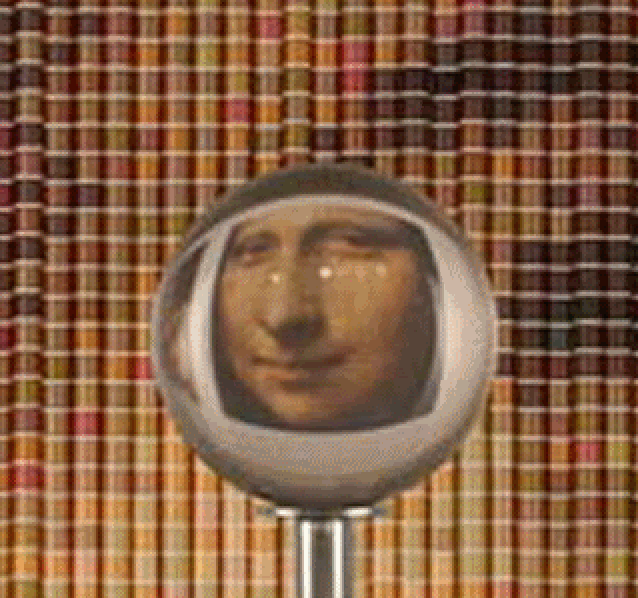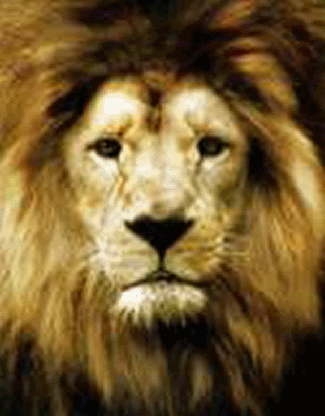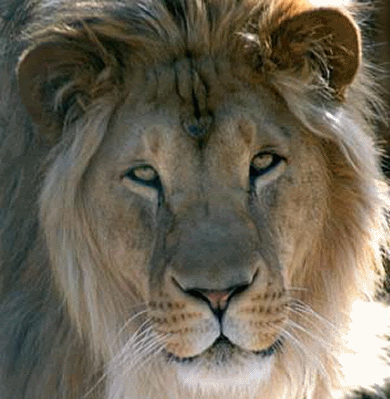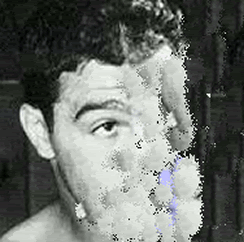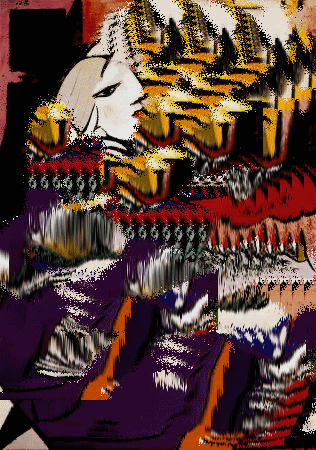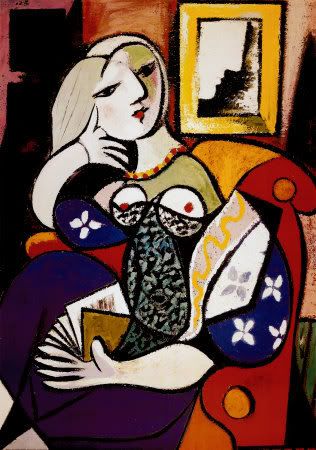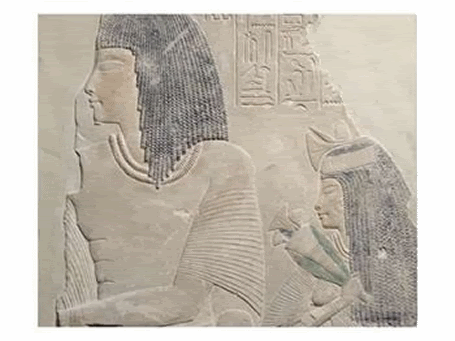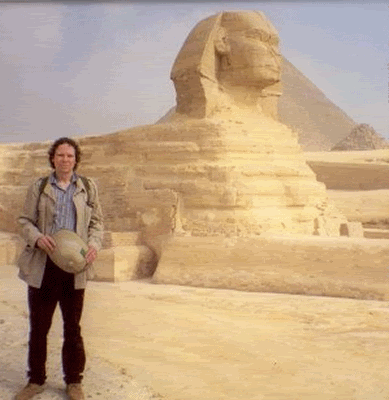- Thank you received: 0
Elaborate Pareidolia and other Mysteries
- neilderosa
-
- Offline
- Platinum Member
-

Less
More
18 years 1 week ago #16796
by neilderosa
Replied by neilderosa on topic Reply from Neil DeRosa
Under the heading of faces that seem to be pareidolia at one scale, but seen at another scale and inverted, they are not, is the strange art of “spool painting” mentioned by me awhile back. The scale differential only seems to be around 5:1 between what appears as a random combination of colors and dots, and a detailed image of a highly realistic face.
Please Log in or Create an account to join the conversation.
- neilderosa
-
- Offline
- Platinum Member
-

Less
More
- Thank you received: 0
18 years 5 days ago #19566
by neilderosa
Replied by neilderosa on topic Reply from Neil DeRosa
Please Log in or Create an account to join the conversation.
- neilderosa
-
- Offline
- Platinum Member
-

Less
More
- Thank you received: 0
17 years 9 months ago #19530
by neilderosa
Replied by neilderosa on topic Reply from Neil DeRosa
One could rephrase the definition of “elaborate pareidolia” to read: “an artistic rendition or enhancement of a pareidolic object giving it sufficient detail (etc.) to create a convincing representation of a face or other familiar object.” If so, then the mirrored “feline half” or damaged half of the Cydonia Face does fit into this category, and does remind one of a lion.
Neil
Neil
Please Log in or Create an account to join the conversation.
- neilderosa
-
- Offline
- Platinum Member
-

Less
More
- Thank you received: 0
17 years 6 months ago #18108
by neilderosa
Replied by neilderosa on topic Reply from Neil DeRosa
When I gave a Power Point presentation of Mars Faces at a meeting in Maryland recently, an objection from a person who thought it was “all pareidolia” was that none of the faces have bilateral symmetry, and faces always have damaged or missing areas. Leaving aside whether this critic was right, this is similar to the line taken by the “pareidoliacs” in the MRMB community. In the interest of engaging our critics while at the same time not renewing the dearly departed year-long ****ing contest we had with them. I make the following comments.
It always bears repeating over and over that that no one denies the psychological phenomenon of pareidolia. But that was never the point. The point is and was: how does one decide (qualitatively) that something is art (artificial made by an intelligent being) and not a random, natural occurrence? My contribution here is to show that it is NOT by deciding whether it is complete, or bilateral, or undamaged, or partially obstructed, OR because it’s on Mars. Neither does the fact that they are predominantly profiles matter.
Here are two “faces” which are partially obstructed. Art appreciation has many intuitive aspects, so I’ll leave it to the reader/viewer to decide WHY he/she thinks these images are art albeit highly damage and obscured, and not pareidolia. [Neil DeRosa]
Fig. 1: realistic but obscured art
Fig.2 impressionistic but obscured art
Fig 3: The Rock
Fig. 4: Picasso painting
Fig. 5: The “real” Nefertiti profile
Fig. 6: The “real” Nefertiti with missing iris
Figs. 7,8: Egyptian profiles
Fig. 9: Schoch in front of damaged Sphinx
It always bears repeating over and over that that no one denies the psychological phenomenon of pareidolia. But that was never the point. The point is and was: how does one decide (qualitatively) that something is art (artificial made by an intelligent being) and not a random, natural occurrence? My contribution here is to show that it is NOT by deciding whether it is complete, or bilateral, or undamaged, or partially obstructed, OR because it’s on Mars. Neither does the fact that they are predominantly profiles matter.
Here are two “faces” which are partially obstructed. Art appreciation has many intuitive aspects, so I’ll leave it to the reader/viewer to decide WHY he/she thinks these images are art albeit highly damage and obscured, and not pareidolia. [Neil DeRosa]
Fig. 1: realistic but obscured art
Fig.2 impressionistic but obscured art
Fig 3: The Rock
Fig. 4: Picasso painting
Fig. 5: The “real” Nefertiti profile
Fig. 6: The “real” Nefertiti with missing iris
Figs. 7,8: Egyptian profiles
Fig. 9: Schoch in front of damaged Sphinx
Please Log in or Create an account to join the conversation.
17 years 5 months ago #18240
by rderosa
Replied by rderosa on topic Reply from Richard DeRosa
I'm not sure why, but I think this belongs here.
NASA Agrees to Search for Files Over 1965 UFO Incident:
www.foxnews.com/story/0,2933,305687,00.html
rd
NASA Agrees to Search for Files Over 1965 UFO Incident:
www.foxnews.com/story/0,2933,305687,00.html
rd
Please Log in or Create an account to join the conversation.
- neilderosa
-
- Offline
- Platinum Member
-

Less
More
- Thank you received: 0
16 years 10 months ago #20115
by neilderosa
Replied by neilderosa on topic Reply from Neil DeRosa
<blockquote id="quote"><font size="2" face="Verdana, Arial, Helvetica" id="quote">quote:<hr height="1" noshade id="quote"> Neil, TVF, rd. etc. If i mail you an analog photograph of a shadow ("Einstein" with 35 countable features- more elaborate than anything found on mars) are you in a position to test it for authenticity and return it to me. i will be glad to lend you the photograph in exchange for a scientific test if i can get a statement of authenticity from you. Thank you, fred ressler (pareidoliac).<hr height="1" noshade id="quote"></blockquote id="quote"></font id="quote">
Elaborate Pareidolia is my theory (working hypothesis) so it is incumbent upon me to answer your question.
I am not an expert in photography so I can not do such an analysis. My feeling is that you must be an expert in this area to have produced your photographic art works. I therefore suggest that you do a kind of scientific paper (or an informal one on the MRMB) in which you take us through all of the steps you followed to produce your art works. This would be, IMO an important scientific contribution, because it would go a long way toward demonstration that elaborately detailed human-like images of faces are common in nature.
The steps should include all of the relevant photographic data. For example, you must start by going out in the field and looking for interesting leaves and branches to photograph. What kind of trees are they? What do the particular *faces* look like when you photograph the leaves directly. If what we are seeing are *shadows* of the originals you must posses a lot of originals that were not cropped and enhanced to become your final product. I suggest you take us through all of the photographic steps (with visuals leading from A to Z, and to the final product) in such a way that we can decide for ourselves how leaf and branch shadows can become eyes, ears, lashes, lips, and so on in your images. My fallback opinion is that these are Photoshop enhancements done with a cloning tool (or equivalent); please show me how Im wrong.
I know this would entail some work on your part, but if you succeed in demonstrating that these details exist in nature, it would be an important contribution to pareidolia science. [Neil]
P.S. the Elaborate Pareidolia thread would be the appropriate forum for this work. So I am moving it there.
[edited] It just occurred to me that we use a machine in my work called a "shadow graph" with which we can view our product in a brightly contrasted and enlarged shadow in order to check for finely detailed imperfections. Perhaps your setup uses some such tool whereby the natural shadows and the artistic drawing can be combined in a unique way to produce imaginative art--just a guess. I believe optometrists use such tools.
Elaborate Pareidolia is my theory (working hypothesis) so it is incumbent upon me to answer your question.
I am not an expert in photography so I can not do such an analysis. My feeling is that you must be an expert in this area to have produced your photographic art works. I therefore suggest that you do a kind of scientific paper (or an informal one on the MRMB) in which you take us through all of the steps you followed to produce your art works. This would be, IMO an important scientific contribution, because it would go a long way toward demonstration that elaborately detailed human-like images of faces are common in nature.
The steps should include all of the relevant photographic data. For example, you must start by going out in the field and looking for interesting leaves and branches to photograph. What kind of trees are they? What do the particular *faces* look like when you photograph the leaves directly. If what we are seeing are *shadows* of the originals you must posses a lot of originals that were not cropped and enhanced to become your final product. I suggest you take us through all of the photographic steps (with visuals leading from A to Z, and to the final product) in such a way that we can decide for ourselves how leaf and branch shadows can become eyes, ears, lashes, lips, and so on in your images. My fallback opinion is that these are Photoshop enhancements done with a cloning tool (or equivalent); please show me how Im wrong.
I know this would entail some work on your part, but if you succeed in demonstrating that these details exist in nature, it would be an important contribution to pareidolia science. [Neil]
P.S. the Elaborate Pareidolia thread would be the appropriate forum for this work. So I am moving it there.
[edited] It just occurred to me that we use a machine in my work called a "shadow graph" with which we can view our product in a brightly contrasted and enlarged shadow in order to check for finely detailed imperfections. Perhaps your setup uses some such tool whereby the natural shadows and the artistic drawing can be combined in a unique way to produce imaginative art--just a guess. I believe optometrists use such tools.
Please Log in or Create an account to join the conversation.
Time to create page: 0.275 seconds


